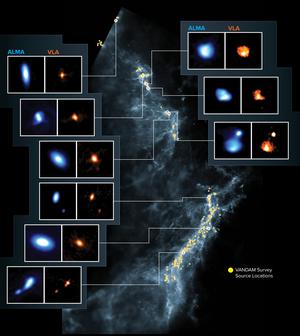Glossary term: Star Formation
Description: The birth of a star results from gravitational collapse of cold and dense regions called cores within giant molecular clouds, which are mostly found in the spiral arms of galaxies. Star formation involves complex physical processes, occurring at different scales, resulting from the effects of gravity, pressure, radiation, magnetic fields, turbulence, chemistry, etc., some of which are still not well understood. Depending on the mass of the parent cloud and accretion processes during the formation stages, the mass of the star can range from 0.08 to a few hundred solar masses. Most stars do not form in isolation but as part of a cluster of stars. During the formation stages, a protostellar disk builds up around the central star, which eventually provides the building material for planets to form.
Related Terms:
See this term in other languages
Term and definition status: This term and its definition have been approved by a research astronomer and a teacher
The OAE Multilingual Glossary is a project of the IAU Office of Astronomy for Education (OAE) in collaboration with the IAU Office of Astronomy Outreach (OAO). The terms and definitions were chosen, written and reviewed by a collective effort from the OAE, the OAE Centers and Nodes, the OAE National Astronomy Education Coordinators (NAECs) and other volunteers. You can find a full list of credits here. All glossary terms and their definitions are released under a Creative Commons CC BY-4.0 license and should be credited to "IAU OAE".
If you notice a factual error in this glossary definition then please get in touch.
Related Media
Witnessing the birth of a star
Credit: ESO/ALMA (ESO/NAOJ/NRAO)/H. Arce. Acknowledgements: Bo Reipurth credit link
License: CC-BY-3.0 Creative Commons Attribution 3.0 Unported icons
Stellar birth environment
Credit: ALMA (ESO/NAOJ/NRAO), J. Tobin; NRAO/AUI/NSF, S. Dagnello; Herschel/ESA credit link
License: CC-BY-3.0 Creative Commons Attribution 3.0 Unported icons










